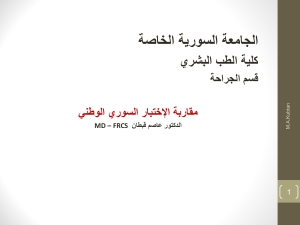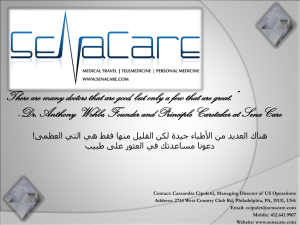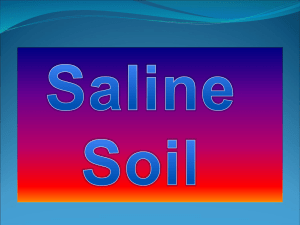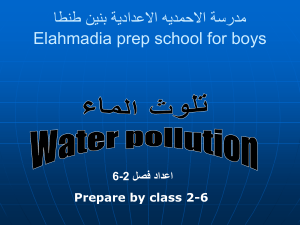The Chemical industry
advertisement
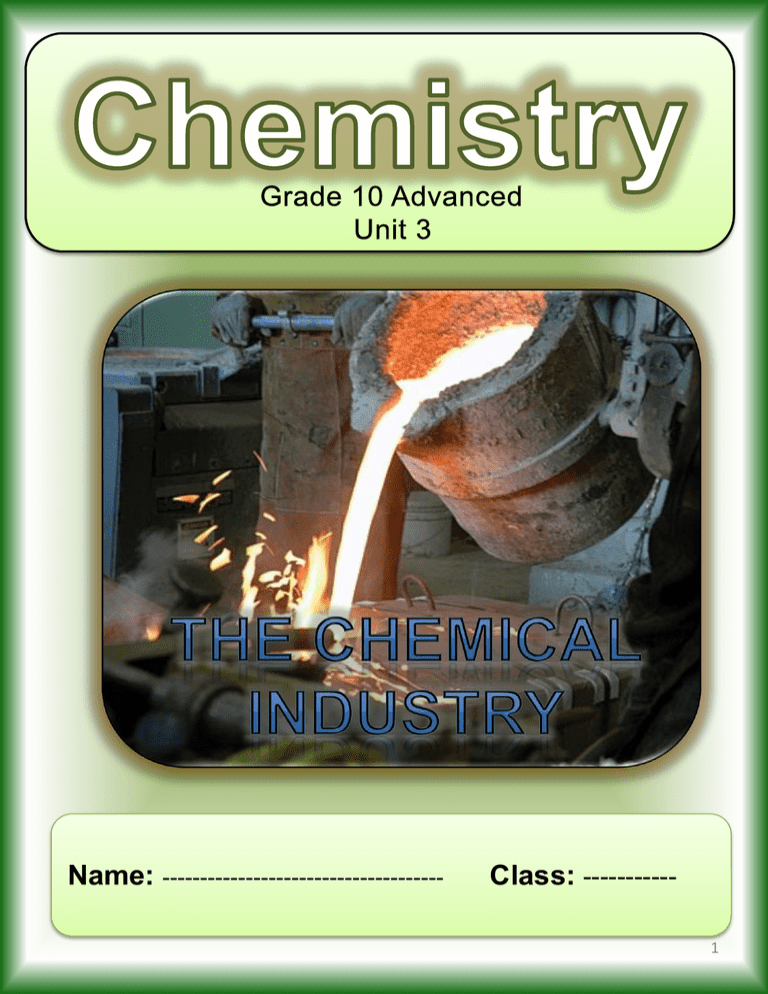
Name: ------------------------------------- Class: ----------1 Unit 3 The Chemical industry By the end of the chapter ,Students know a variety of processes by which useful substances are made from raw materials, including alkalis, chlorine and useful metals. They know that the extractive industries can cause environmental degradation and understand a variety of ways this can be minimised. يعرف التلميذ مجموعة متنوعة من العمليات التي يتم من خاللها، قبل نهاية الفصل يعرف. بما فيها القلويات والكلور والمعادن المفيدة، صناعة مواد مفيدة من المواد الخام أن الصناعات االستخراجية يمكن أن تسبب تدهور البيئة وفهم مجموعة متنوعة من .الطرق التي يمكن أن تقلل من تدهور البيئة 2 Unit3: Chemical industry separate a mixture فصل المخاليط 18.1 Know how purification techniques such as filtration, evaporation, distillation, fractionation and chromatography are used to obtain pure compounds from mixtures. . تستخدم للحصول على مركبات نقية من مخاليط، مثل الترشيح والتبخير والتقطير والتقطير التجزيئي والفصل الكروموتوغرافي،يعرف كيف أن أساليب التنقية Objectives Key Vocabulary Student will be able to: 1. Distinguish between mixture and pure substance. 2. Know how purification techniques are used to obtain pure compounds from mixtures. . purification filtration evaporation distillation fractionation chromatography Something is a MIXTURE if it contains two (or more) substances that are not chemically joined together. .المخلوط هو ما يحتوي على مادتين (أوأكثر) غير مرتبطين بروابط كيميائية The substances in a mixture can often be easily separated from one another. . والمواد في المخلوط عادة ما يمكن بسهولة فصلها مادة عن أخرى A PURE substance only contains one material and so cannot be separated in any way (unless a chemical reaction takes place). .) ولذلك ال يمكن فصلها بأي طريقة (ما لم يحدث تفاعل كيميائي،المادة النقية تحتوي على مادة واحدة فقط * Summary of methods used to separate a mixture PROCESS Filtration الترشيح Evaporation التبخير ملخص لطرق فصل المخاليط What it is used for Examples Used for separating a solid or suspension from a separating SAND from water. liquid يستخدم لفصل صلب أو معلق من سائل .فصل الرمل عن الماء Used to obtain the solute from a solution for obtaining SALT from salty يستخدم للحصول على المذاب من المحلول water الحصول على الملح من ماء مالح Simple distillation Used to obtain the solvent from a solution for obtaining pure water from sea التقطير البسيط . يستخدم للحصول على المذيب من المحلولwater الحصول على الماء النقي من ماء البحر Fractional Used to separate one liquid from a mixture of Obtaining ALCOHOL (bp78C) distillation different liquids that have different boiling from mixture of water and alcohol. التقطير التجزيئيpoints. 78 الحصول على الكحول (درجة غليانة .يستخدم لفصل سائل من خليط من عدة سوائل لها غليان مختلفة .درجة مئوية) من مخلوط للماء مع الكحول Chromatography Used to separate out one color from a mixture of for separating out the colors in الفصل الكروموتوغرافيcolors black ink يستخدم لفصل لون محدد من مخلوط من عدة ألوان .فصل األلوان من حبر أسود 3 Unit3: Chemical industry Lab work Diagrams below show suggested experiment setting for the various separation techniques.األشكال التوضيحية ادناه توضح أعداد تجارب عملية لمختلف تقنيات الفصل Filtration Evaporation In chromatography technique, only a small amount of mixture samples are required, often as little as a drop. تتطلب كمية قليلة فقط من، في تقنية الفصل الكروموتوغرافي . عادة بحجم قطرة، المخلوط The concept behind this techniques is that different constituent in a mixture have different solubility. As the solvent moves up the paper the less soluble constituent will travel at a slower rate than those of more soluble constituents. .والفكرة التي بنيت عليها هذه التقنية هو ان المكونات المختلفة في المخلوط لها ذوبانية مختلفة فعندما يتحرك المذيب ألعلى الورقة يتحرك المكون األقل ذوبانا ً بمعدل أقل من من المكونات .األكثر ذوبانية Hence the mixture will eventually separate into different colored spots as the solvent moves to the top. ومن ثم سيتم في نهاية المطاف فصل المخلوط إلى بقع ملونة مختلفة المذيب عندما يتحرك المذيب . يتحرك إلى األعلى . 4 Unit3: Chemical industry Diagram on the right shows equipment set-up for fractional distillation. For simple distillation, the set-up is similar, except that the fractionating column is being removed. The curving structure of the fractionating column is to increase the surface area and encourage condensation of liquids with higher boiling points. Sometimes the column consists of a tube tightly packed with glass beads. يظهر الرسم التخطيطي على اليمين أدوات أعدت ألجراء تقطير تجزيئي والشكل. إال أنه يتم إزالة العمود، التقطير العادي يتم بطريقة إعداد مماثلة المنحني في عمود التجزئة يعمل على زيادة المساحة السطحية وتشجيع .تكثيف السوائل األعلى في درجات الغليان .في بعض األحيان يتكون العمود من أنبوب محكم األمتالء بحبات من الزجاج The thermometer reading ensures that suitable temperature is reached at the boiling point of the desired liquid to condense out. This should be the liquid with a lower boiling point in the mixture. قراءة الترمومتر تضمن أن يتم التوصل إلى درجة حرارة المناسبة لدرجة غليان السائل المطلوب لتكثيفه الى . و يجب أن يكون هذا السائل األقل نقطة غليان في المخلوط. الخارج Read more: http://www.mikecurtis.org.uk/mixtures.htm http://sciencepark.etacude.com/projects/separations/separation2.php 5 Unit3: Chemical industry Exercises Q1) The following methods can be used to purify substance: الطرق التالية يمكن أن تستخدم لتنقية المواد A. Distillation B. Fractional distillation. C. Evaporation. D. Chromatography. Which method would be most suitable for? أي طريقة تكون مناسبة ل 1. Showing that orange squash is colored by two artificial dyes? ( 2. Getting water from salt solution? ( ) ) 3. Separating a mixture of methanol and ethanol using differences in boiling points? ( ) 4. Getting solid salt from salt solution? ( ) 6 Unit3: Chemical industry الهواء Air 18.2 Know the properties and uses of the main gases of air; describe and understand the process of fractionation of liquid air to produce pure gases. .يعلم خصائص وإستعماالت الغازات الرئيسية التي يتكون منها الهواء؛ يصف ويفهم عملية التقطير التجزيئي للهواء المسيّل إلنتاج غازات نقية Objectives Key Vocabulary Student will be able to: 1. State the main gases of air. 2. Know the properties and uses of the main gases of air. 3. Explain the process of fractionation of liquid air to produce pure gases. . main gases of air fractionation Air is a mixture of various gases. The following table shows the main gases in air and some of their properties and uses: . الهواء خليط من غازات متنوعة : الجدول التالي يوضح الغازات الرئيسية في الهواء وبعض خصائصها وأستخداماتها Gas Ratio compared to Dry Air (%) Molecular Mass الكتلة الجزيئية By volume By weight Chemical Symbol Boiling Point (oC) Common uses األستخدامات respiration and in Oxygen 20.95 23.20 32.00 O2 Nitrogen 78.09 75.47 28.02 N2 Carbon Dioxide 0.03 0.046 44.01 CO2 -182.95 oxy-acetylene torches في التنفس ولهب األكسي استيلين cooling and as an inert -195.79 atmosphere في التبريد وكوسط خامل -78.5 food industry as soft drinks في الصناعات الغذائية .مثل المشروبات الغازية 7 Unit3: Chemical industry Liquefying the air: إسالة الهواء Air is filtered to remove dust, and then cooled in stages until it reaches –200°C. At this temperature it is a liquid. We say that the air has been liquefied. عند هذه الدرجة. 200°C- ثم يبرد على مراحل حتى يصل،يرشح الهواء ألزالة الغبار . ونقول أن الهواء تمت إسالتة.يكون سائل Here's what happens as the air liquefies: واآلن ماذا يحدث بعد أسالة الهواء water vapor condenses, and is removed using absorbent filters ويزال بأستخدام فالتر ماصة للماء، يكثف بخار الماء carbon dioxide freezes at –79ºC, and is removed . ويزال79ºC - يتجمد ثاني أكسيد الكربون عند oxygen liquefies at –183ºC –183ºC يسال األكسجين عند nitrogen liquefies at –196ºC –196ºC يسأل النيتروجين عند The liquid nitrogen and oxygen are then separated by fractional distillation. .ثم يفصل األكسين المسال والنيتروجين المسال بعد ذلك بالتقطير التجزيئي http://www.bbc.co.uk/schools/gcsebitesize/science/edexcel/oneearth/usefulproductsrev2.shtml 8 Unit3: Chemical industry Exercises Q1) Draw a flow chart showing the stages of the fractionation of liquid air? أرسم خارطة تدفق توضح مراحل التقطير التجزيئي للهواء المسال؟ 9 Unit3: Chemical industry Fractional distillation of crude oil التقطير التجزيئي للنفط الخام 18.3Know how a variety of fuels and other useful compounds can be obtained from petroleum and natural gas. يعرف كيف يمكن الحصول على أنواع مختلفة من الوقود وغيرها من المركبات المفيدة من النفط الخام ومن الغاز الطبيعي Objectives Key Vocabulary Student will be able to: 1Explain the fractionation of petroleum to different component. 2. Link the properties of the different fractions to their uses. fuels petroleum When crude oil reaches the refinery it is a thick black, smelly liquid. In this form, it is not much use to anyone. . وهو بهذه الحالة ليس له أي أستخدام. يصل النفط إلى المصفاه سائل أسود كثيف القوام ذو رائحة Crude oil contains mixture of hydrocarbons. (Compounds that contain only carbon and hydrogen) )يحتوي النفط الخام على خليط من هيدروكربونات (المركبات التي تحتوي فق على كربون وهيدروجين At the refinery these are separated into fractions which are more useful. This is done by fractional distillation. . يتم ذلك بواسطة عملية التقطير التجزيئي.ً وفي المصفاة التي تجزأ النفط إلى أجزاء أكثر أستخداما http://www.science-resources.co.uk/KS3/Chemistry/Chemical_Reactions/Hydrocarbons/Distillation.htm 10 Unit3: Chemical industry Crude oil enters the fractionating column as gas. النفط الخام يدخل عمود التجزئة كغاز The column is quite hot at the bottom and cooler at the top. أسفل العمود ساخن جداً وأبرد عند القمة This difference in the temperature up and down the column sorts the different fractions from each other. .األختالف في درجة الحرارة أعلى وأسفل العمود يفصل األجزاء المختلفة من بعضها البعض The larger hydrocarbons, with the high boiling points, turn back into liquids at the base of the column and the smaller hydrocarbons stay as gases. تعود مرة أخرى الى قاعدة العمود والهيدروكربونات، الهيدروكربونات الكبيرة ذات درجات الغليان المرتفعة .األصغر تبقى على هيئة غازات They rise up the column and condense at different levels, as shown in the above diagram. كما هو موضح في الشكل أعاله،ترتفع الغازات أعلى العمود وتكثف عند مستويات مختلفة At the top of the column there are a number of hydrocarbons with low boiling points - between 20ºC and 70ºC. These remain as gases. . وتبقى كغازات70ºC و20ºC يوجد أعلى العمود عدد من الهيدروكربونات ذات درجات غليان منخفضة بين The discovery of the crude oil has played a very big part in the development of modern life. It provides the fuel for most of today's transport as well as the raw material for making various chemical like PLASTICS. فهو يوفر الوقود لمعظم وسائل المواصالت في.وأكتشاف النفط الخام لعب دوراً كبيراً في تطوير الحياة الحديثة .الوقت الحاضر كما تقدم المواد الخام لعمل الكثير من المواد الكيميائية مثل المواد البالستيكية There are a few things you must know about hydrocarbons. .هناك بعض النقاط يجب أن تعرفها عن الهيدروكربونات As the size of the hydrocarbon molecule increases: بزيادة حجم جزئ الهيدروكربون The boiling point increases. تزداد درجة الغليان Looks much darker in color. تبدو أكثر قتامة في اللون Becomes less flammable تصبح أقل قابلية لألشتعال Becomes less useful تصبح أقل استخدام Becomes more viscous (i.e. it does not run easily) تصبح أكثر لزوجة ًتصبح أقل تطايرا Becomes less volatile (doesn't evaporate so easily). 11 Unit3: Chemical industry Exercises Q1) Fractional distillation separates crude oil into useful products called fractions. Look at the diagram below. It shows the different products that can be made from crude oil. أنظر للشكل الذي.عملية التقطير التجزيئي تفصل النفط الخام الي نواتج مفيدة تسمى مشتقات . يوضح النواتج المختلفة التي يمكن أن نحصل عليها من النفط الخام 1. The fraction that exits at the bottom of the column is called_______________. 2.The fraction that exits at the top of the column is called _________________. 3.This fraction contains two gases, called propane and _________________. 4. Fractional distillation works because of the differences ___________________________________ of each fraction. 5. The fractions in order of boiling points are: 1. petrol 2. _________________ 3. _________________ 4. _________________ 5. ________________ 6. Crude oil is a mixture of different hydrocarbons. What are hydrocarbons made of?________________________ 7. On the diagram above label the coldest point and the hottest point? 12 Unit3: Chemical industry Hardness in water الماء العسر 18.4 Know what is meant by hardness in water and how it is produced naturally. Distinguish between temporary and permanent hardness. ً يعلم ماذا نعني بمصطلح العسر في الماء وكيف يتكوّ ن هذا العسر طبيعيا. يميّز بين العسر المؤقت والعسر الدائم Objectives Key Vocabulary Student will be able to: 1- Define hardness of water 2- Explain how hard water is formed in nature. 3- Distinguish between temporary and permanent hardness Hard water soft water lather Hardness in water is defined as water that does not produce lather with soap solutions, but produces white precipitate (scum). Because of the presence of calcium (Ca2+), and magnesium (Mg2+ ) metal cations, in form of bicarbonates and sulfates (calcium or magnesium bicarbonate or sulfates). Hard water is generally not harmful to one's health. يعرف الماء العسر بأنه الماء الذي اليكون رغوة مع محلول الصابون لكنه ينتج رواسب بسبب وجود ايونات . الماء العسر غير ضار بصحة اإلنسان.الكالسيوم والماغنسيوم في صورة أمالح بيكربونات وكبريتات One of the primary disadvantages to hard water and the reason it is described as, “hard,“ is more soap, detergent, shampoo, and/or cleanser, is required to get whatever you are washing clean. It is literally, harder to get anything clean with hard water. Hard water builds up scale on the inside of water pipes eventually reducing the size of your pipe work. Hard water coats your water heater increasing the cost of heating water. يحتاج إلى كميات.اللطخات و الترسبات التي يتركها على المغاسل و أحوض الحمامات: بعض مشاكل الماء العسر أذا لم يعالج تترسب االمالح على شكل.كبيرة من الصابون والشامبو والمنظفات لتنظيف األواني و الشعر والمالبس .قشرة على األنابيب وسخانات المياه مما يزيد من كلفة التسخين Resources : http://en.wikipedia.org/wiki/Hard_water#Process http://www.naturalhealthtechniques.com/basicsofhealth/water_files/waterhardvssoft.htm New chemistry for you: Page 290-292 hard water 13 Unit3: Chemical industry •What makes water hard? Calcium usually enters the water as either calcium carbonate (CaCO3), in the form of limestone and chalk, or calcium sulfate (CaSO4), which is slightly soluble in water. The source of magnesium is dolomite (CaMg(CO3)2). Calcium carbonate is not soluble in water ,but rain water can dissolve it because it contains a weekly acidic gas CO2 which reacts with carbonate to form bicarbonate which is soluble in water. The following is the equilibrium reaction when calcium carbonate (CaCO3) is dissolved in water: CaCO3(s) + CO2(aq) + H2O ⇋ Ca2+(aq) + 2HCO3-(aq) *ما الذي يجعل المياه عسرة ؟ .يدخل الكالسيوم في الماء من التربة الجيرية(الحجر الجيري) ومن كبريتات الكالسيوم شحيحة الذوبان في الماء لكن,بما أن كربونات الكالسيوم التذوب في الماء. (Ca Mg(CO3)2) ومصدر الماغنسيوم صخور الدولوميت مياه األمطار تعمل على إذابتها إلحتوائها على غاز ثاني أكسيد الكربون الحمضي(يكون حمض الكربونيك) الذي .يتفاعل مع الكربونات ويحولها الى بيكربونات قابلة للذوبان في الماء Types of hard water A distinction is made between 'temporary' and 'permanent' hard water. 1. Temporary hardness is caused by a combination of calcium ions and bicarbonate ions in the water. It can be removed by boiling the water. Boiling promotes the formation of carbonate from the bicarbonate and precipitates calcium carbonate out of solution, leaving water that is softer upon cooling. ويمكن إزالة، ويعود لوجود أمالح بيكربونات الكالسيوم وسمي بالعسر المؤقت لسهولة التخلص منه:العسر المؤقت بغلي الماء ينطلق غاز ثاني أكسيد الكربون وتترسب كربونات.عسر الماء في هذه الحالة وتحويله إلى ماء يسر .الكالسيوم كونة طبيقة بيضاء على سطح غالية الماء 2. Permanent hardness is hardness (mineral content) that cannot be removed by boiling. It is usually caused by the presence of calcium and magnesium sulfates and/or chlorides which become more soluble in water as the temperature rises. Despite the name, permanent hardness can be removed using a water softener or ion exchange column, where the calcium and magnesium ions are exchanged with the sodium ions in the column. وسمي عسراً دائما ً ألن، ويعود لوجود أمالح كبريتات وكلوريدات المغنيسوم والكالسيوم ذائبة في الماء:العسر الدائم وإنما تحتاج إلى معالجات كميائية مثل عمليات التبادل،أمالح هذه األيونات ال تترسب بعملية التسخين البسيطة .األيوني 14 Unit3: Chemical industry Activity : Enquiry skill 10A.4.2 Give students samples of hard and soft water and some soap and tell them to try to produce a lather. Then ask them to classify the samples as ‘hard’ and ‘soft’ water. Ask them to analyse data on the cation composition in the waters and to link the characteristics of hard water to the Ca2+ and Mg2+ ion content. Exercises 1. Define hard water. -------------------------------------------------------------------------------------------------------------------------------------------------------------------------------2. Limestone is insoluble, however water flowing through limestone becomes hard. a) Explain how calcium ions get into the water? ------------------------------------------------------------------------------------------------------------------------------------------------------------------------------------- b) List the disadvantages of hard water. -------------------------------------------------------------------------------------------------------------------------------------------------------------------------------c) How can you distinguish between temporary and permanent hard water? -------------------------------------------------------------------------------------------------------------------------------------------------------------------------------------15 Unit3: Chemical industry Industrial electrolytic processes 18.5 Explain, including the electrode reactions, industrial electrolytic processes: 1- The electrolysis of brine using a diaphragm cell; 2- the extraction of aluminium from molten aluminium oxide in cryolite; 3- the electrolytic purification of copper. : مثل، بما فيها التفاعالت التي تحدث عند اإللكترودات،إشرح العمليات الصناعية التي تستخدم التحليل اإللكتروليتي18.5 • التحليل الكهربائي (اإللكتروليتي) لمحلول ملح في الماء بإستخدام خلية ذات غشاء؛1 • إستخراج األلومينيوم من أآسيد األلومينيوم المنصهر في الكريواليت(ألومينا ت الصوديوم الفلورية)؛2 .• تنقية النحاس بالتحليل الكهربائي3 Objectives Key Vocabulary Student will be able to: 1-Identify which solutions are electrolytes 2-explain the electrolysis of brine using a diaphragm cell . 3- Explain the reactions at the cathode and at the anode during the electrolysis of brine electrolysis, electrolytes, anode, cathode , brine Electrolysis : is the break – down of a substance by electricity using electrolytic cells. هو تفكك المادة بواسطة الطاقة الكهربية باستخدام الخاليا اإللكتروليتية:التحليل الكهربائي Electrolytes: are liquids (molten compounds or solutions) that conduct electricity- they contain ions that are free to move like salts ,acids, alkali (NaCl , CuSO4 , HCl, NaOH) هي سوائل ( محاليل أو مصاهير ) لها القدرة على توصيل التيار الكهربي الحتوائها على: اإللكتروليتاات مثل اآلمالح واألحماض والقلويات،أيونات حرة الحركة Brine is sodium chloride (salt) solution. It is brought to the chemical plant and electrolyzed . Three important chemicals, NaOH, Cl2, H2, can be obtained by electrolyzing an aqueous NaCl solution (brine). In industry there are several types of cell used ,some of the cells contain a plastic membrane others with diaphragm. The cell is attached to a supply of DC current connected to two electrodes , anode and cathode. (براين) هو محلول ملح الطعام – يؤتى به الى الحقول الكيميائية لتحليله كهربيا حيث يتم الحصول على ثالث هنالك عدة أنواع.مركبات مهمة وهي الصودا الكاوية (هيدروكسيد الصوديوم ) وغاز الكلور وغاز الهيدروجين بعضها يحتوي على غشاء بالستيكي وأخري تحتوي علي غشاء من.من الخاليا المستخدمة في عملية التحليل . قطبين – وهما األنود والكاثود-توصل الخلية بمصدر تيار مباشر من خالل الكترودين. )األسبستس (الحجاب 16 Unit3: Chemical industry Diaphragm cell In the diaphragm cell process, there are two compartments separated by a permeable diaphragm, often made of asbestos fibers. Brine is introduced into the anode compartment and flows into the cathode compartment.. The diaphragm prevents the reaction of the caustic soda (NaOH) with the chlorine. التحليل الكهربائي الحجابي يتم استخدام حجاب من، في خلية التحليل الكهربي الحجابي توجد غرفتين األسبستس( الحرير الصخري) كحاجز بين الغرفتين ليمنع الكلور المتكون على األنود .وهيدروكسيد الصوديوم المتكون على الكاثود من االتحاد مرة أخرى - The reactions inside the cell: 1- NaCl HO Na + + Cl2 - At the anode (+ve electrode ): The chloride ions are oxidized to chlorine: تأكسد أيونات الكلوريد الى كلور: )عند األنود(موجب – – 2Cl → Cl2 + 2e - At the cathode(-ve electrode): hydrogen in the water is reduced to hydrogen gas, releasing hydroxide ions into the solution: يختزل هيدروجين الماء الى غاز الهيدروجين مما ينتج عنه أيونات الهيدروكسيد في: )عند الكاثود(سالب .المحلول 2H2O + 2e– → H2 + 2OH– - The sodium ions (Na+) pass to the second chamber where they react with the hydroxide ions to produce caustic soda (NaOH). The overall reaction for the electrolysis of brine is thus: 2NaCl + 2H2O → Cl2 + H2 + 2NaOH تمر أيونات الصوديوم الى الغرفة الثانية لتتفاعل مع أيونات الهيدروكسيد لتنتج هيدروكسيد الصوديوم Although Na+ ions are present at the cathode ,they are more stable than H+ .when you electrolyze a solution of a highly reactive metal, hydrogen – not the metal – is given off at the cathode. . لذا توجد أيونات الصوديوم الموجبة عند الكاثود مع أيونات الهيدروجين الموجبة لكنها أكثر ثباتا 17 Unit3: Chemical industry Activities : 1- Ask students to carry out a small-scale electrolysis of brine. Tell them to collect the gases produced at the anode and cathode and to test for the presence of hydrogen and chlorine. If a few drops of universal indicator solution are added to the brine before starting, it can be seen to turn from green to purple, indicating the presence of an alkali (NaOH). 2- Ask students to research the uses of hydrogen, chlorine and sodium hydroxide and present them using ppt. Exercises َQ1) during electrolysis of a concentrated aqueous solution of sodium chloride: 1-which ion will be attracted to the anode? ____________________________________ 2-does oxidation or reduction occur at the anode? ________________________________________________________________ 3-write a balanced equation for the reaction at the anode? _______________________________________________ 4-which ion will be attracted to the cathode? ____________________________________________________ 5- write a balanced equation for the reaction at the cathode? _________________________________________________ 6-what would the aqueous solution eventually change into? ___________________________________________________ New chemistry for you Page 82 : electrolysis of sodium chloride – page 104: electrolysis of brine 18 Unit3: Chemical industry Industrial electrolytic processes The extraction of aluminium from molten aluminium oxide in cryolite Objectives Key Vocabulary Student will be able to: 1-state properties and some uses of Al. 2- describes the industrial extraction of Al from molten aluminium oxide in cryolite; 3-explain the reaction at each electrode. electrolysis, electrolytes, anode, cathode , brine Uses of aluminium: Aluminium has many useful properties .It conducts electricity and heat well. It has low density,it also resists corrosion, that is because of the tough layer of aluminium oxide on its surface which protects it. • Transportation (automobiles, aircraft, as alloy • Packaging (cans, foil, etc.) • Construction (windows, doors, siding, building wire, etc.) • A wide range of household items, from cooking utensils to baseball bats, • Outer shells of consumer electronics, also cases for equipment e.g.photographic equipment. • Electrical transmission lines for power distribution. منخفض الكثافة, جيد التوصيل للكهرباء والحرارة. لأللومنيوم العديد من الخصائص المفيدة:استخدامات األلومنيوم بعض من استخدامات.و مقاوم للتآكل وهذا بسبب طبقة صلبة من أكسيد األلومنيوم على سطحه تحميه من التآكل :معدن األلومنيوم العديده في • النقل )العربات والطائرات (كسبائك وما إلى، وأسالك البناء، والتحويالت، األبواب، وما إلى ذلك )البناء (النوافذ، ورق فويل،• التعبئة والتغليف )علب (ذلك • خطوط بث الكهرباء لتوزيع الطاقة ، من أواني الطهي إلى مضرب البيسبول،• مجموعة كبيرة من األدوات المنزلية وتستخدم في. وفى حاالت المعدات أيضا مثل معدات التصوير, • المستويات الخارجية من اإللكترونيات المستهلكة مجال اإللكترونيات واألقراص المدمجة 19 Unit3: Chemical industry Extraction of Aluminium Aluminium ore is called bauxite. Bauxite contains aluminium oxide, water, iron oxide and other impurities. The purified dry ore, called alumina, is aluminium oxide - Al2O3.H2O The alumina must be molten for electrolysis to work,since the ions are not free to move in the solid state. Unfortunately, alumina has a high melting point (2040 °C) and it is not practical to do electrolysis at such a high temperature. In the middle of the nineteenth century it was found that alumina dissolved in cryolite( sodium aluminium fluoride ) Na3AlF6.A solution of alumina in cryolite melts at about 900 °C and electrolysis is done at about 950 °C. و أكسيد الحديد.)Al2O3.H2O البوكسيت هو خام األلومنيوم الذى يحتوي على أكسيد األلومنيوم المائي من التحليل الكهربائيAl يتم الحصول على األلومنيوم. والخام النقي يسمى األلومنيا.وشوائب أخرى (2040 °C) درجة انصهار األلومنيا عالية جدا. Al2O3لمصهور األلومنيا يصهر الخليط.900 °C الىNa3AlF6 .ولتخفيض درجة انصهار أكسيد األلومنيوم يخلط بمادة الكريواليت .لجعل األيونات حرة الحركة أما المصعد فيتكون، تتكون خلية التحليل من وعاء من الحديد مبطن من الداخل بطبقة من الجرافيت كمهبط .من عدة قضبان من الجرافيت متصلة مع بعضها ومغمورة في المصهور ويسحب مصهور األلومنيوم الناتج، Al+3 يتكون األلومنيوم في هذه الخلية عند المهبط حيث تختزل أيونات .من مخرج خاص في أسفل الخلية 20 Unit3: Chemical industry At the anode: oxide ions are oxidized to oxygen gas.The oxygen gas reacts with the hot carbon anode ,it makes CO2 .It burns away the anodes, which must be replaced quite often 2O 2- 4e + O2 يتفاعل غاز األكسجين مع أنود الكربون الساخن ويتكون. تتأكسد أيونات اآلكسيد الى غاز األكسجين:عند األنود .ثاني أكسيد الكربون مما يؤدي الى تآكل األنود ويستدعي استبداله At the cathode: aluminium ions are reduced to aluminium atoms. Molten aluminium is tapped off from the bottom of the cell Al3+ + 3e Al . ويسحب االلومينيوم المنصهر من قاع الخلية. تختزل أيونات االلومينيوم الموجبة الى ذرات الومينيوم: عند الكاثود Exercises Q1) Describe the extraction of aluminium from purified bauxite including simple cell diagram, .اشرح طريقة استخراج االلومينيوم من البوكسيت النقي مع لرسم الخلية Q2) Write the reactions at each electrode. .اكتب التفاعالت التي تحدث عند كل الكترود New chemistry for you Page 89: extraction of aluminium http://home.clara.net/rod.beavon/extraction_of_metals.htm 21 Unit3: Chemical industry Industrial electrolytic processes The electrolytic purification of copper. Objectives Key Vocabulary Student will be able to: 1-state some uses of copper. 2- describe the electrolytic purification of copper 3-write the reactions at the electrodes during electrolysis. electrolysis, electrolytes, anode, cathode , brine Copper plays a vital role in shaping our lives. People have been using copper since 9000 BC. One of the reasons copper is so important is that it can be made into alloys. You can find copper all over the place. In your home it is hidden away in everyday objects, including phones, water pipes, locks and electrical wiring. It is an excellent conductor of electricity and heat. وتصنع منه العمالت. قبل الميالد9000 استخدم االنسان النحاس منذ. يلعب النحاس أهمية حيوية في حياتنا ، ويوجد في معظم األدوات التي تحيط بنا مثل اسالك الكهرباء.المعدنية كعملة نحاسية و يدخل ضمن السبائك وهو موصل جيد للحرارة والكهرباء- أنابيب المياه،التليفونات Copper wire Copper Purification مخطط خلية التحليل الكهربي لتنقية فلز النحاس The cathode is a thin piece of pure copper The anode is a block of impure copper. 22 Unit3: Chemical industry At the anode :When electricity is passed through the cell copper is dissolved by oxidation, Cu2+ ions go into solution. Cu(s) - 2e- Cu2+(aq) .الى المحلولCu2+ عند امرار التيار الكهربي في الخلية يتأكسد النحاس لدى االنود وتنتقل ايونات النحاس The impurities from the anode drop to the bottom of the cell .This sludge contains valuable metals, like gold and silver .وتترسب الشوائب في قاع الخلية وهي تتكون من معادن قيمة مثل الذهب والفضة At the cathode: copper is deposited by reduction Cu2+(aq) + 2e- Cu(s) As copper ions move from the anode to the cathode the anode gets smaller as the cathode gets bigger. من األنود يقل وزنه ويزداد وزن الكاثود الذي يترسب عليهCu2 + عندما تنتقل ايونات النحاس .ويبقى تركيز محلول كبريتات النحاس ثابتا.النحاس The rate at which the copper ions enter the electrolyte from the anode is the same as the rate at which the copper ions leave the electrolyte at the cathode. The concentration of the copper(II) sulfate solution therefore remains unchanged. ويبقى تركيز-ان معدل دخول ايونات النحاس في االلكتروليت من االنود يساوي معدل خروجها عند الكاثود .محلول كبريتات النحاس ثابتا Activity :Enquiry skill 10A.2.3 Show a video of the extraction of aluminium and the purification of copper by electrolysis. Tell students to work in small groups to produce annotated flow charts of one of the processes. اطلب من التالميذ في.أعرض فديو الستخراج االلومينيوم وآخر لتنقية النحاس بالتحليل الكهربي .مجموعات صغيرة عمل بوستر الحدى الطرق New chemistry for you Page 95: getting pure copper http://scienceaid.co.uk/chemistry/applied/copper.html 23 Unit3: Chemical industry Exercises Q1) Is the Anode made from Pure or Impure Copper? هل يصنع االنود من نحاس نقي ام نحاس غير نقي؟ Q2) Which Compound is used as the Electrolyte during Purification? ما هو المركب الذي يستخدم كاليكتروليت في عملية تنقية النحاس؟ Q3) Write the equation for the Reduction of Copper at the Cathode. .اكتب معادلة اختزال النحاس عند الكاثود Q4) Give two Uses of Copper اذكر استخدامين للنحاس 24 Unit3: Chemical industry Industrial importance of the halogens 18.6 Know the industrial importance of the halogens and their compounds as in,for example, the manufacture of bleaches, PVC, halogenated hydrocarbons as solvents and refrigerants, and insecticides, and be aware of the main environmental hazards associated with these uses. مثل إستعمالها في صناعة منتجات التبييض والبي في سي والهيدروكربونات الهالوجينية وكمذيبات ومواد،يعرف األهمية الصناعية للهالوجينات ومركباتها . ويعي األخطار البيئية الرئيسية المتعلقة بإستعماالتها،تبريد ومبيدات حشرية Objectives Key Vocabulary Student will be able to: 1-Name the halogens and some of their compounds. 2-Know the importance of halogens in the manufacture of bleaches,PVC, halogenated hydrocarbons. 3-Describe the main environmental hazards associated with these uses. • halogens, • bleaches, • hazards, • insecticides Halogens: Are non-metal elements in group 7in the periodic table, Fluorine F2 ,chlorine Cl2 ,bromine Br2 ,Iodine I2 . All halogens form diatomic molecules. They are reactive elements and their reactivity decrease from fluorine to iodine.They form great number of useful compounds like NaCl,NaOCl,KI ,PVC,CCl4 ,CFCs,DDT ،الكلور، هي عناصر الفلزية تقع في المجموعة السابعة في الجدول الدوري وتتكون من الفلور: الهالوجينات . تدخل في تركيب كثير من المركبات المفيدة.توجد فب صورة جزيئات ثنائية الذرة.البروم و اليود * Uses of halogens and their compounds: As bleach: The first large-scale use of chlorine was in the manufacture of bleaching powder for use in bleaching paper and cotton . Chlorine is used as a bleach ,it reacts with water: Chlorine + water Cl2 + H2 O hydrochloric acid + chloric (1) acid (bleach) HCl + HOCl Bromine is a weaker bleach ,iodine is even weaker. أما البروم مبيض ضعيف الفعالية.يستخدم الكلور بكميات كبيرة في عمليات تبيض األقمشة القطنية والورق .وكذلك اليود 25 Unit3: Chemical industry 2- PVC and halogenated hydrocarbons: Halogens can react easily with hydrocarbons(organic compounds) to give halogenated hydrocarbon like C2H3Cl , this compound is used as monomer to obtain polymer PVC –polymer vinyl chloride.PVC is used in manufacture of raincoats ,handbags ,pipes, rigid botteles and more other materials. تتفاعل الهالوجينات مع مركبات الهيدروكربون لتنتج عدد كبير من المركبات العضوية مثل الذي يستخدم في صناعة معاطفPVC وهذا المركب يستخدم كمونمر لصناعة بوليمرC2H3Cl المطروالشنط وصنع األنابيب البالستيكية التي تتصف بالمتانة وتغليف األسالك البالستيكية وغيرها من .اإلستخدامات 3-Ferions:group of compounds known as Chloro Fluro Carbon (CFCs) .example CCl2 CF2 it is unreactive colorless odorless gas because of that those compounds are used as solvents, as aerosol propellants. refrigerants and air conditioners-fire extinguisher. عديمة اللون و، –غير نشطة كيميائياCCl2 CF2 الفريونات هي مركبات كلورو فلورو كربون مثل .الرائحة لذا تستخدم كمذيبات وبخاخات وفي المبردات و طفايات الحريق 4-insectcides: chlorine is used in the preparation of insecticide like DDT which used to kill insects that cause malaria and typhoid as well as against agricultural pests. Halogens are used to kill bacteria therefore sterilizing water for domestic supply or in swimming pools. Chlorine compounds are used in disinfectants like 'dettol' or 'TCP'. Iodine water is also used as a disinfectant prior to surgery . ت الذي يقتل الحشرات التي تنقل المالريا.د.يستخدم الكلور في تحضير المبيدات الحشرية مثل د .والتيفويد والفطريات الزراعية كما يستخدم.كما تستخدم الهالوجينات في تعقيم مياه الشرب و برك السباحة والمطهرات مثل الديتول محلول اليود في التعقيم أثناء العمليات الجراحية 26 Unit3: Chemical industry The environmental hazards associated with the uses of halogens: المخاطر البيئية الناتجة من استخدام الهالوجينات The halogens are potentially harmful substances. Fluorine and chlorine in particular are highly toxic. It is highly dangerous to ingest or breathe halogen vapour or their solutions. تمثل خطورة عالية عند بلعها أو استنشاق. الفلور والكلور مواد عالية السمية.الهالوجينات مواد ضارة ابخرتها Ferions :because of their low densities they reach the upper atmosphere without decomposing.They reacts with ozone layer in presence of ultra violet rays leading to depletion of the ozone layer. إنها تتفاعل مع طبقة. بسبب كثافتها المنخفضة ترتفع الى طبقات الجو العليا دون أن تتحلل:الفريونات .اآلوزون في وجود األشعة فوق البنفسجية مما يؤدي الى تآكل طبقة األوزون Use of insecticides : DDT posed unacceptable risks to the environment and potential harm to human health.DDT is toxic to a wide range of animals in addition to insects, including marine animals such as crayfish, fish certain birds species. مادة سامةDDT . البيئة لمخاطر كبيرة كما أنه ضار بصحة االنسانDDT يعرض ال:الميدات الحشرية . لكثير من الحيوانات والحشرات وكذلك الطيور والحيوانات البحرية مثل االسماك Activity : Ask students to find out about the uses of other halogens and to add this information to their findings about chlorine. . اطلب من الطلبة أن يبحثوا عن فوائد الهالوجينات الخري إضافة الى فوائد الكلور:نشاط http://www.pan-uk.org/pestnews/Actives/ddt.htm 27 Unit3: Chemical industry Iron & steel 18.8 Describe, with essential chemical reactions, the extraction of pig iron from iron ore in the blast furnace and its subsequent conversion into steel in the basic oxygen furnace. إستخراج حديد الزهر من خام الحديد في فرن الصهر وتحويله الالحق الى فوالذ في الفرن األكسيجيني القاعدي،يصف مع ذكر التفاعالت الكيميائية الرئيسية 18.7 Describe, with essential chemical reactions, the extraction of steel from iron ore and recycled scrap iron in the electric arc furnace. . في فرن القوس الكهربائي مع ذكر التفاعالت الكيميائية األساسية في هذه العملية،يصف إستخراج الفوالذ من الحديد الخام ومن حديد الخردة المعاد تدويره Objectives Key Vocabulary Student will be able to: 1-state the main sources of iron. 2- explain the reaction that occurs in the plast furnace 3-explain the conversion of iron into steel using the basic oxygen converter.. 4- Describe the extraction of steel from iron ore in the electric arc furnace . • plast furnace, • steel, • recycled scrap, • basic oxygen furnace, • pig iron Extraction of iron using blast furnace Iron Perhaps the most important element ever known to mankind and one of earth's most abundant element. Iron (Fe) is extracted from Iron ore. The process of extracting iron - done either through ‘blast furnace’ route or by ‘direct reduction’ route - involves a number of steps Common iron ores are hematite (Fe2O3) and magnetite (Fe3O4). Iron in the ore is reduced to iron metal by heating with carbon (coke). Reactions in the blast furnace: التفاعالت داخل الفرن الالفح 1. The coke (produced by heating coal in the absence of air) burns in the blast of hot air to form carbon dioxide; exothermic reaction releases heat. This reaction is the main source of heat in the furnace. C + O2 CO2 يستخدم فحم الكوك الذي ينتج من تسخين الفحم الحجري حيث يحترق داخل الفرن بامرار تيار من الهواء .الساخن ليكون ثاني أكسيد الكربون في تفاعل طارد للحرارة 28 Unit3: Chemical industry 2- At the high temperature at the bottom of the furnace, carbon dioxide reacts with carbon to produce carbon monoxide. C + CO2 2CO وفي درجة الحرارة العالية داخل الفرن يتفاعل ثاني أكسيد الكربون مع مزيد من فحم الكوك ليكون أول أكسيد الكربون 3-It is this carbon monoxide which reduces the iron oxide to iron Fe2O3 + 3CO 2Fe + 3CO2 ثم يختزل أول أكسيد الكربون أكسيد الحديد الى حديد The temperature of the furnace is hot enough to melt the iron which trickles down to the bottom as ‘pig iron’, where it can be tapped off. نتيجة للحرارة العالية يتكون الحديد منصهر(الحديد الزهر) حيث يتحرك لألسفل ويسحب 4-The limestone is added to convert impurities into ‘slag’ ) as calcium silicate, CaSiO3), which melts and runs down through the furnace to form a layer on top of the molten iron. CaCO3 CaO + SiO2 CaO + CO2. CaSiO3 يضاف الحجر الجيري ليحول الشوائب الى "خبث" مصهور مثل سليكات الكالسيوم التى تتحرك الى أسفل .مكونة طبقة فوق الحديد المنصهر 29 Unit3: Chemical industry Iron into Steel: Most of the molten iron from a Blast Furnace is used to make one of a number of types of steel. There isn't just one substance called steel - they are a family of alloys of iron with carbon or various metals like chromium and nickel. معظم الحديد المستخرج من الفرن الالفح يحول الى أنواع من الحديد الصلب بخلطه مع الكربون أو فلزات أخرى .متنوعة مثل الكروم و النيكل * Steel-making: the basic oxygen process (BOP) Oxygen Converter is a furnace used to convert pig iron into steel.It consists of a rotating vessel coated with dolomite( calcium and magnesium carbonate) Impurities with the iron from the Blast Furnace include carbon, sulphur, phosphorus and silicon. These have to be removed .The still impure molten iron is mixed with scrap iron (from recycling) and oxygen is blown on to the mixture. The oxygen reacts with the remaining impurities to form various oxides. Elements like phosphorus and silicon react with the oxygen to form acidic oxides. These are removed using (basic oxides - quicklime - calcium oxide and magnesium oxide) which is added to the furnace during the oxygen blow. They react to form compounds such as calcium silicate or calcium phosphate which form a slag on top of the iron. C + O2 Si + O2 P4 + 5 O2 CO2 SiO2 P4O10 هو فرن يستخدم لتحويل الحديد الزهر إلى صلب،Oxygen Converter المحول األكسجينى (كربونات كالسيوم- عبارة عن بوتقة كبيرة تتحرك حول محور ومبطنه من الداخل بخام الدولوميت: تركيبه وماغنسيوم) ينفذ من فوهته انبوب خاص لدخول االكسجين : طريقة عمل المحول االكسجين . يشحن المحول بمصهور الحديد الغفل أو الزهر.1 . يدفع األكسجين النقي بسرعة كبيرة وتحت ضغط عال خالل فوهة المحول.2 FeO. MnO . P2O5 . SiO2 فتتأكسد الشوائب وجزءا من الحديد وتتكون االكاسيد التالية.3 . تتحد االكاسيد مع بعضها البعض مكونة خبثا ً ويزال بامالة المحول حول محوره.4 30 Unit3: Chemical industry An electric arc furnace : An electric arc furnace (EAF) is a furnace that heats charged material by means of an electric arc .An electric arc furnace consists of a refractory-lined vessel, one or more graphite electrodes enter the furnace. Solid substances used in the electric arc furnace are melted predominantly by electrical energy which is inputted via the electrodes, as well as energies in the presence of oxygen.The electrodes are automatically raised and lowered by a positioning system. Oxygen is injected via pipe lance to "cut" the scrap. This oxygen will react with several components in the bath including silicon, manganese, phosphorus, carbon and iron. All of these reactions are exothermic (i.e. they generate heat) and supply additional energy to aid in the melting of the scrap. The metallic oxides that are formed will end up in the slag. The same reactions as in the oxygen converter. : يتكون فرن القوس الكهربائي من وتوجد في سقف الفرن ثالث فتحات يمرر فيها ثالثة قضبان. أسطوانة فوالذية ضحلة مبطنة بالطوب الحراري . من الكربون يطلق عليها األقطاب وينتج عن هذه األقواس. )يقفز(تيار كهربائي قوي من كل قطب إلى مادة الشحنة ومنها إلى القطب اآلخر كما تساعد الحرارة العالية في حدوث،الكهربائية كميات ضخمة من الحرارة التي يمكنها صهر الشحنة بسرعة وتحدث نفس التفاعالت كما فى المحول. لتنتج في النهاية كميات كبيرة من الفوالذ،التفاعالت الكيميائية .األكسجينى http://www.youtube.com/watch?v=9KV6nlqGXoM&NR=1 http://science.creaforum.net/montada-f4/topic-t328.htm New chemistry for you Page 75- 76 : extraction of iron 31 Unit3: Chemical industry Exercises Q1) which substance is the main reducing agent in a blast furnace? ?ما هي المادة التي تستخدم كعامل مختزل رئيسى داخل الفرن االفح _______________________________________________________________ Q2) iron(III) oxide is reduced by carbon in the furnace:i) write a word equation for this reaction. .يختزل اكسيد الحديد بواسطة الكربون داخل الفرن – اكتب معادلة لفظية لهذا التفاعل _______________________________________________________________ a)write a symbol equation for this reaction. اكنب المعادلة الرمزية له _______________________________________________________________ Q3) What is the main impurity in the iron from a blast furnace? ما هي الشوائب الرئيسية التي توجد مع الحديد المستخرج من الفرن الالفح؟ _______________________________________________________________ _______________________________________________________________ Q4) Describe the conversion of iron into steel using the basic oxygen converter اشرح عملية تحويل الحديد الى صلب باستخدام المحول االكسجيني القاعدي؟ ______________________________________________________________ ______________________________________________________________ ______________________________________________________________ 32 Unit3: Chemical industry Copper 18.9 Describe the production of copper matte from its ores .يصف إنتاج النحاس مطفأ اللمعان من خاماته Objectives: Explain the main stage to production copper matte from its ores Key Vocabulary . Electrorefining, efined , extraction Ores, Concentration, Roasting, Smelting Copper extraction from its ores involves a series of processes. First the ore must usually be concentrated. Then it must be roasted to convert sulfides to oxides, which are smelted to produce matte. Finally, it undergoes various refining processes, the final one being electrolytic. The main ore in use today is chalcopyrite (CuFeS2), which accounts for about 50% of copper production. ثم يجب أن. أوال يجب أن تتركز الماده الخام.استخراج النحاس من الخامات يمر بسلسلة من العمليات فإنه يخضع لعمليات التكرير، وأخيرا. والتي تصهر إلنتاج المصهور، يحمص لتحويل كبريتيد إلى أكاسيد والذي، الماده الخام الرئيسيه للنحاس اليوم هو كالكوبايرايت.ً والناتج النهائي يتكرر كهربائيا، المختلفة . من إنتاج النحاس٪ 50 يشكل حواليCuFeS2 1. Concentration Most copper ores contain only a small percentage of copper metal bound up within valuable ore minerals. The first stage of any process within a metallurgical treatment circuit is comminution, where the rock particles are reduced in size وthereafter followed by a process of physical liberation of the ore minerals from the rock. The process of liberation of copper ores depends upon whether they are oxide or sulfide ores. التركيز .معظم خامات النحاس تحتوي على نسبة صغيرة من معدن النحاس مرتبطة بمعادن خام ثمينة حيث يتم تقليل حجم الجسيمات، المرحلة األولى من أي عملية داخل دائرة العالج المعدنية هوالسحق ثم بعد ذلك من خالل عملية التفكك الفيزيائية يتم الحصول على،,الصخرية التي تحتوي على المادة الخام عملية تفكك خامات النحاس يتوقف بناء على ما إذا كانت كبريتيد أو خامات.الصخر. المعادن الخام من .أكسيد 33 Unit3: Chemical industry 2. Roasting: In the roaster, the copper concentrated is partially oxidised to produce calcine and sulfur dioxide gas. the reaction which takes place is: 2CuFeS2(s) + 3O2(g) → 2FeO(s) + 2CuS(s) + 2SO2(g) المحمصة ويحدث التفاعل.في المحمصة تتأكسد جزيئات النحاس المركزة إلنتاج الكلس و غاز ثاني أكسيد الكبريت :كالتالي 2CuFeS2(s) + 3O2(g) → 2FeO(s) + 2CuS(s) + 2SO2(g) 3. Smelting The calcine is then mixed with silica and limestone and smelted at 1200 °C (in an exothermic reaction) to form a liquid called copper matte. This temperature allows reactions to proceed rapidly, and allow the matte and slag to melt, so they can be tapped out of the furnace. In copper recycling, this is Several reactions occur. For example iron oxides and sulfides are converted to slag which is floated off the matte. The reactions for this are: FeO(s) + SiO2 (s) → FeO.SiO2 (l) reaction the iron sulfide is converted to slag: 2FeS(l) + 3O2 + 2SiO2 (l) → 2FeO.SiO2(l) + 2SO2(g) الصهر ألنتاج سائل النحاس ( في التفاعالت الطاردة للحرارة ) يتم خلط الكلس مع السليكا والحجر الجيري وتصهر .1200 عند درجة حرارة درجة الحرارة هذه تسمح للتفاعل بالحدوث بشكل سريع وتسمح للمعادن باالنصهار واالستفاده من المصهور .خارج الفرن أكسد الحديد والكبريت يتحوالن الى مادة:تحدث تفاعاالت مختلفه في عملية اعادة التدوير للنحاس مثال FeO(s) + SiO2 (s) → FeO.SiO2 (l) : خام كما في التفاعل التالي :ويتحول كبريتيتد الحديد الى مادة خام منصهره كما في التفاعل التالي 2FeS(l) + 3O2 + 2SiO2 (l) → 2FeO.SiO2(l) + 2SO2(g) 34 Unit3: Chemical industry 4. Electrorefining The copper is refined by electrolysis. At the cathode, copper metal plates out but less noble remain in solution. The reactions are: At the anode: Cu(s) → Cu2+(aq) + 2e– At the cathode: Cu2+(aq) + 2e– → Cu(s عند المهبط ينفصل النحاس عن اللوح ولكن المتبقي في المحلول ال يكون، يتم تنقيه النحاس عن طريق التحليل الكهربائي .نقيا بشكل تام 2+ – Cu(s) → Cu (aq) + 2e : عند المصعد Cu2+(aq) + 2e– → Cu(s : عند المهبط Exercises Q1) Summarized the basic steps for the extraction of copper from its ores: لخص الخطوات األساية إلستخراج النحاس من مواده الخام 35 Unit3: Chemical industry Recycling إعادة التدوير 18.10 Be aware that large-scale extraction and refining processes are often damaging to the environment and that this has to be balanced against the benefits of the processes; list some of the steps taken to minimise environmental degradation in the processes studied. وأنه ينبغي موزانة هذا الضرر،يعي أن عمليات إستخراج وتنقية المعادن من خاماتها على نطاق واسع تسبب في معظم األحيان ضرراً للبيئة .مقابل الفوائد الناتجة عن هذا العلميات؛ يسرد بعض الخطوات المعتمدة للتقليل من التلف البيئي الناتج عن هذه العمليات 18.11 Understand the importance of recycling products such as metals and plastics and of designing products to make recycling easier. . مثل المعادن ومنتجات البالستيك وأهمية تصميم المنتجات بطريقة تسهّل إعادة تدويرها،يدرك أهمية إعادة تدوير (إعادة تصنيع) المنتجات Objectives: 1.Explain Environmental impact of metal extraction. 2.List the Steps used to reduce the environmental damages. Key Vocabulary: Environmental, damages, industry, recycling . Bringing essential minerals has long been associated with environmental degradation and harmful social impacts. Consequently, this sector’s primary sustainability challenge is to minimize its direct impacts and to contribute to improved re-use and recycling of the finite resources it has mobilised. كان، وبالتالي.الحصول على المعادن األساسية مرتبط و منذ فترة طويلة بتدهور البيئة واآلثار االجتماعية الضارة .البد من تقليل األثار المباشرة والمساهمة في تحسين وإعادة استخدام و تدوير الموارد المحدودة Environmental impact of metal extraction Before metals can be extracted from their ores, the land is mined for ores. Mined land is usually and it cannot support plant and animal life. An enormous amount of waste material is also generated from the extraction process. األثر البيئي الستخراج المعادن الملغومة األرض هي عادة وانها. ويتم استخراج األرض للخامات، قبل أن تتمكن من استخراج المعادن من خاماتها .هي ولدت أيضا وجود كمية هائلة من النفايات من عملية االستخراج.ال تستطيع دعم الحياة النباتية والحيوانية 36 Unit3: Chemical industry About 90% of the metal ore used for metal extraction turns out to be waste and be needs to be disposed of after the metal is extracted. If not disposed of carefully, the waste may leach into soil and nearby water bodies, polluting land and water. To dispose of the waste, huge landfill sites need to be dug. The smelting of ores also causes more air pollution compared to any other industrial process. In addition, the extraction of metals is usually generated from burning fossil Fuels. من خام المعادن المستخدمة في استخراج المعادن تتحول الى نفايات ويتم التخلص منها بعد استخراج٪ 90 حوالي . وقد تنتشر النفايات في المسطحات المائية والتربة وتلوث األرض والمياه، إن لم يتم التخلص منها بعناية.المعادن فتصهر الخامات فيتسبب أيضا في مزيد من. ومواقع دفن النفايات الضخمة تحتاج إلى حفر، للتخلص من النفايات فإن المعادن تستخرج من حرق الوقود، وباإلضافة إلى ذلك.تلوث الهواء مقارنة مع أي دولة أخرىغير صناعيه .األحفوري الوقود Steps used to reduce the environmental damages: 1. Transformation of some released gases to other products used in industry e.g use the SO2 (g) to produce H2SO4 (Sulphuric acid) that is widely used in industry. 2. Reduction of metals extraction from their ores by encouraging the re-use and the recycling methods. 3. Use the Bioleaching. This technique is a new technique used by the mining industry to extract specific metals ( such us gold and copper) from their ores through the use of bacteria. : *الخطوات المتبعة للتقليل من األضرار البيئية تحويل بعض الغازات المنبعثة إلى غيرها من المنتجات المستخدمة في صناعةعلى سبيل المثال استخدام.1 .الذي يستخدم على نطاق واسع في الصناعةH2SO4 إلنتاج حامض الكبريتيكSO2 غاز . تخفيض استخراج المعادن من خاماتها عن طريق تشجيع إعادة استخدام وإعادة تدوير األساليب.2 هذه التقنية هي تقنية جديدة تستخدم من قبل التعدين صناعة استخراج المعادن محددة. استخدام التصفية الحية.3 (مثل لنا الذهب والنحاس) من خاماتها من خالل استخدام البكتيريا 37 Unit3: Chemical industry Advantages of recycling: If metals are recycled and reused, there will be less need to dig for metal ores. With a decrease in mining operations, land will be free for other uses such as agriculture. Air and water pollution Will also be greatly reduced. Fewer landfills will be required to Dispose of both used metal objects and waste material from metal Extraction. This will help save on the cost of building landfill sites. By recycling metals instead of extracting them from ores, we are also conserving our limited fossil fuel reserves. : مزايا التدوير مع انخفاض. ستكون هناك حاجة أقل للتنقيب عن خامات معدنية،إذا تم إعادة تدويرالمعادن وإعادة استخدامها كما أن تلوث الهواء والمياه سوف. وسوف تكون حرة الستخدامات أخرى مثل الزراعة، في عمليات التعدين و سوف تكون هناك حاجة أقل للتخلص من األجسام المعدنية المستعملة والنفايات من.ينخفض الى حد كبير عن طريق إعادة تدوير. وسوف يساعد هذا على توفير في تكلفة بناء مواقع دفن النفايات.استخراج المعادن . ونحن أيضا لدينا محدودة حفظ احتياطي الوقود األحفوري، المعادن بدال من استخراج لهم من الخامات How are some metals commonly recycled? Lead, iron and aluminium are mainly recovered by scrap metal recycling. Lead is recovered from car batteries. When a car battery no longer works, the lead inside it is reused. A large fraction of iron and steel produced today is also recycled from scrap metal. Aluminium is recycled mainly from drink cans and food containers. كيف يعاد تدوير بعض المعادن؟ الرصاص.يتم استرداد أساسا الرصاص والحديد واأللومنيوم عن طريق إعادة تدوير الخردة المعدنية مما يؤدي الى اعاده تدوير واستخدامها مرة, عندما ال تعمل بطارية السيارة.يسترد من بطاريات السيارات يتم إعادة.يعتمد انتاج نسبة كبيرة من الحديد والصلب اليوم عن طريق إعادة تدويرها من الخردة المعدنية.اخرى .تدوير األلومنيوم بشكل رئيسي من علب المشروبات والغذاء الحاويات 38 Unit3: Chemical industry Exercises Q1) Answer the following question: a) Write some Advantages of metals recycling: أكتب بعض من فوائد اعاده تدوير المعادن ____________________________________________________________ ____________________________________________________________ ____________________________________________________________ ____________________________________________________________ b)What are the Environmental impact of metal extraction: ما هي األثار البيئية إلستخراج المعادن ____________________________________________________________ _____________________________________________________________ ______________________________________________________________ 39
